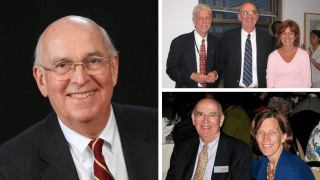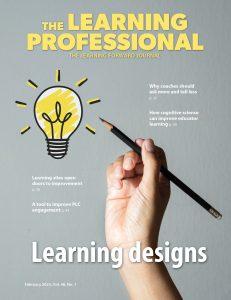As one of 22 districts in the Redesign PD Community of Practice, the New York City Department of Education is focusing on measuring the impact of professional learning for teachers and other educators in the district. Implementing the tools of improvement science has given the district a concrete plan for tracking progress. Read about how the approach is helping schools and central office departments make continuous improvement.
Educators in the New York City schools have a variety of virtual learning opportunities on WeTeachNYC.org, an online platform. But Juliette Heinze, the executive director of the district’s Knowledge Sharing team, sees room for growth in how teachers and other personnel engage in using the system and in communicating with colleagues.
That’s the challenge she had in mind when she and her team participated in a new professional development series last fall on using improvement science–a process for implementing a change and testing whether—and how—it is an improvement.
“Solving this challenge would have a key impact on how educators in our system connect with one another and share and co-construct knowledge and experiences with new skills and practices,” Heinze says.
The Continuous Learning team, part of the New York City Department of Education’s Division of Teaching and Learning, launched the sessions last spring as a pilot program to help schools and central office teams take a scientific approach to solving their unique challenges.
“Our city’s schools are called upon to build on their existing inquiry practices and engage in cycles of learning to address and solve key problems of practice impacting student success,” says Courtney Smith, senior director of the Continuous Learning team.
Julie Leopold, the executive director of Continuous Learning for the nation’s largest school district, adds that her team’s participation in the Redesign PD Community of Practice is an important part of making sure improvement science is implemented well.
“Through the Learning Forward community of practice, our colleagues have pushed us to systematically attend to participant shifts in learning and practice with an eye toward impact on student achievement,” Leopold says. “We now have a concrete plan for studying participant artifacts to track impact.”
In the first phase of the pilot, administrators and teacher leaders from five schools came together for the three-part professional learning experience focusing on improvement science tools. The participants gained skills in how to apply improvement science by asking three questions summed up in “Learning to Improve: How America’s Schools Can Get Better at Getting Better,” by Anthony S. Bryk, president of the Carnegie Foundation for the Advancement of Teaching.
- What is the specific problem I am trying to solve?
- What change might I introduce and why?
- How will I know whether the change is actually an improvement?
The school teams then turned around and involved four to six additional staff members at their schools in the problem-solving effort. The teams also received coaching from a member of the Continuous Learning team as they implemented their improvement plan.
But the team didn’t want the learning to remain only in the professional development sessions. So the participants have also been gathering in an online blended community on WeTeachNYC.org to share how they are applying the problem-solving principles in their schools and to exchange reflections and artifacts of their work.
Using what they’ve learned, the schools have tackled a diverse mix of issues, ranging from how to make individual education program meetings more productive and improve parent engagement to strengthening teacher collaboration and aligning the social studies curriculum at the high school level.
After the spring pilot, the Continuous Learning team made adjustments, based on early impact data, and then presented the sessions to 40 staff members at the central office level. Their feedback will be used to strengthen the content for the next round with a new pilot group of 10 schools in early 2017. In that phase, two teams from each participating school will “explore the foundational tools of improvement science and then will apply the tools and practices…to an authentic problem of practice,” Smith says.
Heinze’s team was one of seven at the central office to participate in the improvement science sessions.
“Engaging in the sequenced steps of a cycle of learning within the PD space sparked a deeper reflection across our team about how we can shift to thinking about how, not just if, a change we’re implementing is working,” Heinze says.
The Continuous Learning team will continue to coach and support the schools that are participating in the blended community. Those involved in the spring pilot will also provide feedback to the team to further improve the professional learning sessions before they are offered citywide.
Smith adds that being part of the Redesign PD Community of Practice “drives our team to name and seek out resources, expertise, and support strategically throughout the design, implementation, and analysis phases of our work.”
Involvement in the community has also pushed her group to better measure whether professional learning is effective—especially related to the higher levels of professional learning expert Tom Guskey’s framework. Level four focuses on how participants use the skills they have learned, and level five measures the effects of professional learning on student outcomes.
“The community check-ins push us to name our successes and our challenge points,” Smith says, “which keeps us accountable to our team and to our commitment to helping to translate learning into improved practices in classrooms across NYC— rather than solely within the PD space.”
Overview of Continuous Learning team
The Continuous Learning team works to build the capacity of adults across the system to identify problems, iterate new approaches, measure impact, and develop sustainable improvement. The team helps schools, boroughs, districts, and central office staff focus on the how of school improvement by providing broad support through resources and centralized professional learning opportunities while also providing deep support through direct coaching in small cohorts of schools, districts, boroughs, and central teams.
Continuous Learning team goals 2016-17
- Targeted stakeholders will develop their ability to support colleagues to engage in cycles of learning, through knowledge, skills, resources, and structures.
- Targeted stakeholders will make measurable progress toward solving an authentic problem that impacts student outcomes/educator practice/conditions for schools through engagement in the steps of a complete cycle of learning.
- Targeted stakeholders will develop a deep understanding of inquiry tools and be able to apply tools with confidence.
- Targeted stakeholders will develop an improvement mindset.


![Poil blog v1[1]](https://learningforward.org/wp-content/uploads/bb-plugin/cache/poil-blog-v11-custom_crop.jpg)




